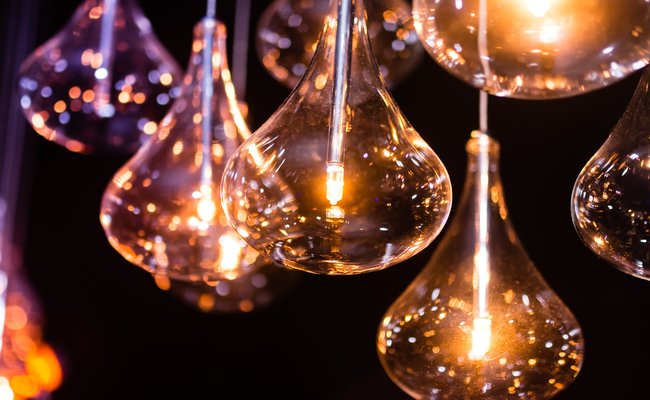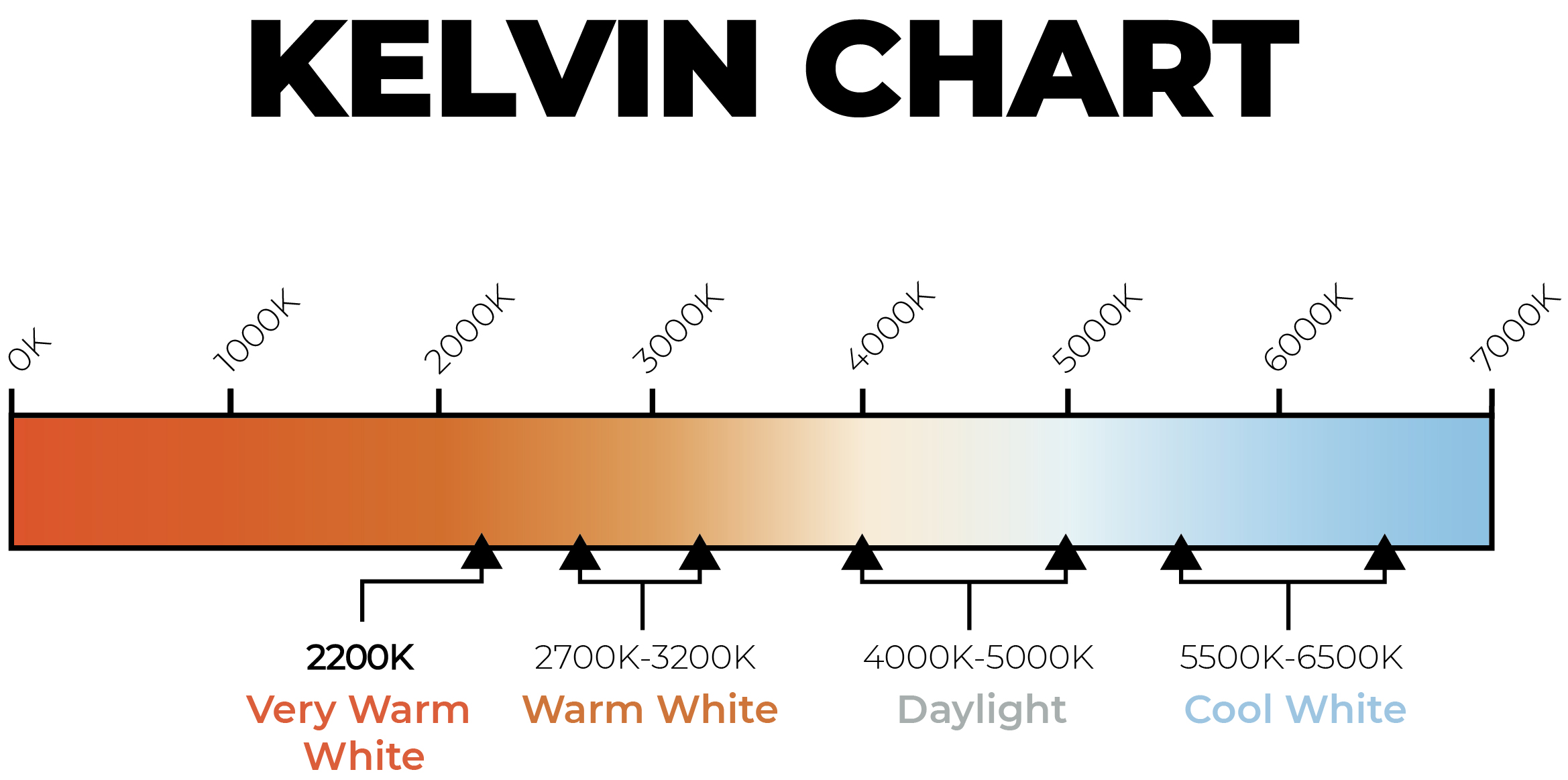Warm Lighting: Understanding the Basics

Recent research has shown that lighting can greatly affect people’s moods. To create a cozy and relaxing atmosphere, many lighting experts recommend warm lighting. As a type of lighting fixture, warm lighting is widely used in residential decoration. But if you are not familiar with home lighting fixtures, you may not know what warm lighting really is. This guide will explain what warm lighting is and what it is best used for.
What is Warm Lighting?
Color temperature is measured in Kelvin degrees. Warm lighting is generally orange or red in hue and has a color temperature below 4000° Kelvin. The most commonly used warm lighting has a 3000° Kelvin temperature, though a 3500° Kelvin temperature light is whiter, but still warm. Neutral lighting is between 3500 and 4000 Kelvin and has a predominant light hue of white.
By contrast, cool lighting represents light sources with color temperatures between 4000K and 6500K. These chillier colors tend to move beyond white to a bluish tone, with a blue light recording a temperature of 6500 Kelvin. To understand what 5000K cool lighting looks like, picture pure ice.
Benefits of Warm Lighting
Warm lighting is popular for both home and business lighting, as it makes the environment feel more inviting and cozy.
Warm lighting promotes relaxation
Warm and cool color temperatures each affect us differently. Warmer colors like red, orange, or yellow have lower color temperatures and create a relaxing atmosphere. Research has determined that warmer lighting is associated with deep relaxation.
Warm lighting changes the appearance of objects
Light yellow or orange-toned lighting can change how objects appear. Though some view this as a negative, it can be used to great advantage for decorating purposes. Accessories and paintings that might look out of place in a coolly lit room can look stunning in a warmly lit area.
It’s important to understand this effect, as makeup applied under warm lighting will have an entirely different effect under cool lighting, or even outdoors.
Warm lighting is idea for eyesight protection
Warm lighting sources are ideal for optimal eyesight protection. Many modern windows allow natural light in while blocking UV rays that can harm your eyes. Artificial cool lighting with color temperatures higher than 4000K emits more ultraviolet rays than warm lighting.
Warm lighting optimizes photographic and video images
Lighting experts say that warm lighting is more attractive for portrait photography and filmmaking. Many famous movie directors use warm lighting when shooting. To understand the effect, think about how the warm glow from a sunset changes the look and feel of an outdoor space.
Recommendations for Using Warm Lighting in Your Home
Here are some ideas for the best use of warm lighting in your home.
Bedroom
Bedrooms are where we most need to relax and have a cozy atmosphere. Warm lighting can help make your bedroom more inviting, though it may not be a good choice if your bedroom doubles as an office: warm lights can make people feel tired and drowsy.

Living room
A warmly lit living room creates a welcoming atmosphere in which to enjoy family time. Warm lighting will also neutralize the colors of your décor, imbuing it with rich tones. Keep in mind that if your furnishings include traditional wooden cabinets or other deeply colored furnishings, warm lighting is not recommended.

Bathroom
Though warm lighting can be used in bathrooms and will make you feel more relaxed, most decorators recommend the use of cool lighting to make the area look clear, crisp, and bright.

A Quick Guide to Color Temperature
People mainly divide lighting into two types: “warm” and “cool”. These two different types of lighting are categorized according to their color temperature. So what is the color temperature?
Color temperature is the term to describe the color of a visible light source by comparing it to the color of light emitted by an idealized opaque, non-reflective body. In terms of common light bulbs we usually use, it is a way to describe the light appearance provided by a light bulb. Color temperature is measured in Kelvins(K) with a scale from 1000K to 10000K.
Color temperatures for lighting applications in commercial and residential settings typically range from 2000K to 6500K. The scaling rule is: the warmer the color, the lower the color temperature. Just as mentioned above, warm lighting is often orange or red in hue with a color temperature below 4000° Kelvin. Check out the chart below.

Warm vs Cool Lighting: What's the Difference?
The chart below will provide an at-a-glance guide to the differences between warm and cool lighting.
How to Select the Right Light Bulbs
Now that you know the differences between warm and cool lighting, here are some tips for choosing the right light bulb for different areas of your home.
Determine where they will be used
The first step in choosing the right home lighting is determining where they will be used. Different rooms have distinct lighting requirements. For example, the lighting for your bedroom should be warmer and softer than the lighting in your bathroom.
Choose the right category of bulb
In addition to color temperature differences, light bulbs are also available in a wide range of categories, including incandescent, fluorescent, and LED. Incandescent bulbs emit warmer light colors but are power-inefficient. Fluorescent bulbs emit cool white light but can be harsh on your eyes. LED bulbs are more expensive but are more energy-efficient and environmentally friendly.
Consider lighting combinations
Using just one type of lighting inside your home is not recommended. Instead, find the right balance of warm and cool lighting, keeping in mind that dimmer switches can be used to great effect when you want to control the amount of light in a room.
Energy usage
Watts (W) are the unit of measure of power that quantifies electricity usage: higher wattage light bulbs generate more heat and use more power, while lower wattage bulbs use less energy. The most common maximum wattage for domestic light fixtures is 60 watts. However, appliances with light bulbs are more likely to have a lower maximum wattage limit. For example, common wattage for LED light bulbs is from 8 to16 watts.
Labels of the light bulb itself should provide a indication of the maximum wattage. If not, contact the manufacturer. You can choose more energy-efficient light bulbs to save power and be more eco-friendly.
Best Ways to Add Warm Lighting
Because warm lighting creates a cozy, relaxing atmosphere, it is a popular choice for home use. In addition to choosing lower color temperature light bulbs, there are other ways to add warm lighting.
- Use smart, tunable color-changing light bulbs. These smart LED light bulbs allow you to adjust their color to warmer orange or soft yellow tones.
- Use a small night light. Night lights are typically thought of as just being for kids, but they are used by people of all ages. Electric candle versions provide warm lighting, with lower color temperatures than traditional light bulbs.
- Hang string lights. String lights are usually soft yellow or warm white. Hanging them from your ceiling will add warmth and charm.
- Add wall sconces. Wall sconces come in beautiful shapes and styles, adding an extra design element while providing warm lighting.
FAQs
What colors are used in warm lighting?
Warm lighting is usually orange, yellow, or red in hue with a color temperature below 4000° Kelvin. The most common warm lighting corresponds to 3000° Kelvin temperature, while a 3500° Kelvin light is whiter but still warm.
How does lighting affect mood?
Different colors can generate different feelings, and this is true of lighting color temperature too. For example, a warm temperature light below 3000K can evoke feelings of coziness, comfort, and relaxation by creating a soothing and intimate atmosphere.
Where should I use warm lighting?
Bedrooms are the ideal location for warm lighting unless they include workstations where you need to remain alert. Living rooms are great too. Both rooms are well served by lighting that evokes a sense of relaxation and a cozy and comfortable atmosphere.
Can lamps add warmth to my room?
There are many different types of lamps that can add warmth just by installing the right temperature of light bulb.
Conclusion
Warm lighting refers to lighting with color temperatures below 4000° Kelvin. The most commonly-used type of warm lighting is rated as 3000° Kelvin temperature. Warm lighting promotes relaxation, offers protection for eyesight, and has many additional benefits.
For residential applications, warm lighting is highly recommended in areas including bedrooms, living areas, and bathrooms. Have you switched to warm lighting and experienced any of these benefits? Have you felt your mood change based on a room’s lighting? Leave your comments in the section below. We’d love to hear from you!
Search
Be in the Know
Security insights & offers right into your inbox
